| (ARCHIVE) Vol. XIX No. 10, september 1-15, 2009 |
|
Quick Links
Walk the talk
Archaeological sites near Chennai destroyed
Dancing all the way
An anthem for Chennai as Kodambakkam celebrates
A variety of events from Avadi to the Marina
| Walking the talk
|
| By Vincent D’Souza |
|
|
Remember Deepa Sekar of Kilpauk, who took the first steps to organise a Kilpauk Heritage Walk on Madras Day?
Close to 30 people took part in it and in that group was the well-known writer and novelist, Timeri Murari, whose family history is entwined with that of Kilpauk in many ways. Deepa, who specialises in making paper jewellery, mailed me to say that the Walk had made a significant impression in her life. “I now know how special Kilpauk is and that it not only has a life but also a soul,” she said.
And added, “How I wish my school and many others taught history differently – by walking the talk!” I wrote back to tell her that she should continue to organise the Kilpauk Heritage Walk throughout the year – for schools and community groups.
Here is one shining example of how Madras Day is contributing to the city’s outlook.
On the eve of Madras Day...
It is well past 10 p.m. Christopher Roy from Nandanam calls me up. He wants to talk about Madras Day. These are calls I cannot refuse (and I wouldn’t pass on this job to a call centre!).
Roy grew up in the campus of the YWCA on Poonamallee High Road and he wants to highlight the Great Pond in this campus.
A water body which has seen its best and worst but has remained a well-nurtured water body for many, many years. Roy learnt of the Madras Day late but wanted to do something simple.
So we agreed to invite the neighbourhood kids and students to the Y campus and jot their impressions about the Great Pond.
Small but significant local events like this are what have made the concept of Madras Day a unique, evolving, community-driven process.
Back to top
|
|
|
Archaeological sites near Chennai being destroyed |
| By a Special Correspondent |
|
|
At 8 a.m. I took the bus from Adyar to Thiruporur, the same route I had taken every day that July in 2008. On the bus, two girls were talking about renting houses on the OMR, about their new IT jobs and their swanky new offices. A couple of students rode on the footboard, ready to jump off at the entrance of one of the engineering colleges. Eventually, all the IT professionals and college students had alighted and only the lungi-clad men from around Thiruporur remained. Once we reached the outskirts of Chennai, the glass facaded, cool, new IT complexes and the huge gateways to the engineering colleges were replaced by factories and small, sleepy villages. The contrast was stark; the main income of the people here was from working in the factories – if they were lucky. If they were not, they toiled in the sand quarries, or became goatherds or farmers. Land plays a pivotal role in the economic and social system here, whether it is used to build houses for multinational companies, to farm, or graze livestock or even to mine the sand for building material to be used in Chennai.
My doctorate thesis is based on an archaeological site in this area: a 2000 year old megalithic burial site. The site reveals over 300 burials, covering an area of about 500 acres. These burials are full of mystery. Who built them, why were they built, and why were there so many different types of burials?
This site has been excavated under the supervision of Dr. Sathyabhama Badhreenath of the Archaeological Survey of India, and Dr. Hema Achyuthan of the Geology Department, Anna University.
Over the course of two months I worked on the excavation of eight burials and in that time I became familiar with some of the people living in the local villages who worked with us at the site. One of the women who worked with us, a widow with two children, had no other income. Her brother-in-law has three children and he has to earn enough working as a mason to support not only his family but also that of his wife’s. Looking at it from their perspective, the megalithic burials seemed more like cobwebs in their home which needed to be cleared.
On my last visit to the site, the village Thalaivar had plotted out the land and a small house was built amongst the megalithic burials and, surely, more houses will be built in the coming months. I have been visiting this site since 2006 and in that time I have seen people dig up burials inadvertently while quarrying for sand, new houses raised amongst the ruins, and even an excavator razing the burials while laying road.
Different countries have different laws to deal with site preservation. Some countries even have laws that prevent prospecting of archaeological sites using metal detectors. Is it not ironic that due to lack of awareness, our sites face destruction while in some countries too much awareness makes these sites just as vulnerable! The US has an Act which ensures special treatment to the funerary remains of the American Indians called the Native American Graves Repatriation Act (NAGRA) of 1990. The social and economic situation of different countries requires different methods to be used in the preservation of archaeological sites. In India, too, we have acts and legislations which are meant to preserve the archaeology. However, lack of awareness, corruption and just the numbers of people and sites that need to be preserved act as barriers.
The Indian Government enacted quite a few Acts between 1878 and 1972, the purpose of which ranged from protecting and preserving antiquities to acquiring permission to excavate archaeological sites as well as preserving and protecting archaeological sites. Some of these are the Indian Treasure Trove Act 1878, the Ancient Monuments Preservation Act 1904, the Antiquities Export Control Act 1947, etc. Despite this, we are losing many archaeological sites, largely due to lack of awareness. The Chennai Metropolitan Development Authority talks about restoration and preservation of heritage buildings and environmental issues, but no mention is made of archaeological sites. The Archaeological Survey of India is mentioned but no clear understanding of how the Chennai Metropolitan Development Authority will help stop the destruction of these sites is mentioned when working on land development.
The Archaeological Survey of India and State Department of Archaeology are the guardians and protectors of our archaeology, yet it makes sense to think that the people who regulate the city’s development and the archaeologists would collaborate. The sand quarrying hardly feeds the people who dig up this sand; the people who make the money probably do not even live near the site. Similarly, destruction of archaeological sites, especially around Chennai, caused by the buildings of multinational companies and apartment complexes is the same as that of encroachment by villagers on these sites. People make money, but while that happens no one realises how much of our rich heritage is being lost. The first hand axe (Stone Age tool) in India was discovered in 1863 by Robert Bruce Foote near Pallavaram. How many in Chennai know about this or even care? No wonder the destruction and loss of archaeological sites disturbs no one.
Back to top
|
|
| Dancing all the way |
| By Sriram V. |
|
|
A lovers’ stroll from People’s Park to Kapaleeswarar Temple
One of the highlights of Madras Week was a dance-cum-song presentation of a 1915 ballad, the People’s Park Vazhi Nadai Chindu presented by the Narada Gana Sabha Trust’s dance wing and featuring dancer Gayatri Balagurunathan with music by T.K. Padmanabhan.
Chindu-s, or Guzili Pattu-s, were spontaneously created ballads sung at road junctions and important city locations, conveying news, views, messages and descriptions of the city to listeners. This ballad tradition survived till the 1940s.
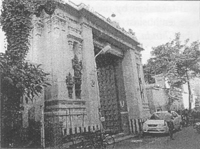
Aranganathaswami Temple. |
Apart from being sung, these ballads were published as pamphlets and sold for quarter or half anna each (Madras Musings, February, 2007). The ballad that was featured during Madras Week was published in 1915 by the Chakravarty Acchukoodam of 13, Nambulayar Street, George Town. The song is about a young man of the area asking his girl, the toast of Mullah Sahib Street, to walk with him to Mylapore to see the Arupathu Moovar festival at the Kapaleeswarar temple. Along the way he describes the landmarks that they see.
The Romeo asks his beloved to join him after dressing in a silk saree and blouse, wearing gold jewellery and applying a variety of native perfumes. Addressing her as a lily-eyed doe, with speech like a nightingale, he leads her from Mullah Sahib Street, a lane off Anna Pillai Street (a long thoroughfare that cuts George Town on an East-West axis) and home to the Aranganathaswami temple of which he sings. The couple enters Anna Pillai Street and offers worship at the Arunachaleswarar Vardarajaswami temple, one of the three twin temples of Madras city (the others being the Chenna Kesava
Chenna Malliswara temple on Devaraja Mudali Street, George Town, and the Adipuriswara Adikesava Perumal temples of Chindadripet).
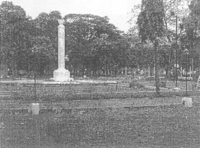
People's Park. |
Turning left on Anna Pillai Street, they walk towards Wall Tax Road passing the Dharmaraja Draupadi Amman temple and emerge via the Elephant Gate (Sowcarpet).
They must have walked south down Wall Tax Road up to the point where it joins Poonamallee High Road. Central Station must have been on the right, but there is no mention of the railway terminus in the song. They must have crossed it, however, and walked towards the right for what is next described is the Victoria Garden, which must be Victoria Public Hall. Walking by People’s Park the hero sings of the My Ladye’s Gardens with its high compound and beautiful gates. The joys inside the garden are also described in detail. There is a pond (Lily Pond?) with a wooden bridge over it; it also has the novelty of piped water being supplied from Puzhal. The song notes several women filling water from the pipes.
The zoo is described next (for it was then within People’s Park). They see male and female bears, a big tiger, a cheetah and what is sung of as “the famous” lion. There is a stone elephant kept in a tin shed, while a gatekeeper charges ½ anna to see it. Boat rides in the pond cost ¼ anna. More animals, such as snakes, foxes, jackals, turtles, civet cats, monkeys, mongooses and rabbits follow, as does a large aviary with every bird imaginable. Describing the place as heaven, the couple then crosses the bandstand where English music is played for the Durais every Tuesday and Saturday in the evenings. People’s Park, according to the song, also contained a tree whose sapling was planted by Prince Albert Victor (this grandson of Queen Victoria came to Madras in 1889). Attention is drawn to Overseer Willis’ bungalow inside the garden. The couple gazes at a lawnmower which can cut uniformly and they marvel at a huge weighing scale used for sizing the bales of grass before auctioning. Ripon Building, which must have been a newly completed edifice then, is conspicuous by its absence in the song.
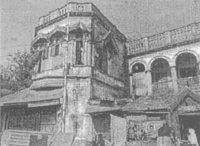
Murugappa Mudaliar's bungalow. |
If they are walking on Poonamallee High Road towards Egmore, the jail is on the left and the duo claims to be able to see murderers, pickpockets and frauds going about their penitentiary duties. They also see the women’s cells and the gardens tended by the convicts. There is, however, no mention of the Government College of Fine Arts by the side of which the couple must have turned left to reach Chintadripet. There is also no reference to St. Andrew’s Kirk which must have clearly been visible on the right.
Today, the access to Chintadripet is via an over-bridge, but in 1915 it must have necessitated waiting at a level-crossing. In Chintadripet, they walk down Lang’s Garden Road, for there is a mention of a grand bungalow of one Muragappa Mudaliar. Today, this is a wretched thoroughfare with the foul Cooum on one side, but it is still possible to see remnants of several grand residences on what must have been a lovely waterfront in 1915. We are possibly near Harris Road, for specific mention is made of crossing Sami Naicken Road, which refers to Sami Naick, the man who pioneered vaccinations in Madras and who lived off Harris Road in Venkata Baugh, in Lang’s Garden Road. A park, much neglected, stands even now in Sami Naick’s name in the area. From here, the couple must have used Harris Bridge, walked on Blacker’s Road and reached Mount Road.
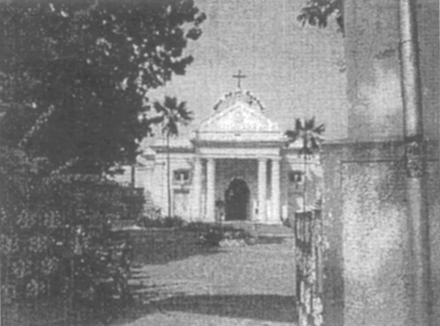
Wesley Church. |
What is the Arupatthu Moovar festival without the tanneer pandals where water, buttermilk and sweetmeats are distributed to those visiting the event? The man sings of a ‘Glasskaaran Tanneer Pandal’ probably on Mount Road and then of a ‘Tailor Taccha Chavadi’ (was it a colony of weavers and carpenters?). They cross a set of square shops built to honour Ashton Durai (a W. Ashton lived on Mount Road in 1883) and are now in Patter’s Gardens (since demolished). At the time this would have been the residence of Lodd Govinddoss, one of the wealthy Gujaratis of the city. Mention is made of Club House (since demolished), better known today as the place which housed The Indian Express group of newspapers for long. In 1915, the Madras Club was here and its rear entrance must have been crossed by the couple, as they walked down Patullo’s Road.
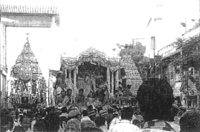
Mylapore temple festival. |
The song next mentions Taana Maada Koil, which could be the Wesley Church, for they say it is next to a school in Royapettah (the Wesley School on Westcott Road). Apparently, Chellappa’s Sweet Shop was the rage of Royapettah, for here the singer asks his girl to savour puri halwa, laddu, jalebi, adirasam, palgova and pakoda.
How they can walk after that meal is a mystery, but walk they do and, crossing the Tandavarayar Tanneer Pandal (near the present-day Tandavarayan Street off Gaudiya Mutt Road, Royapettah), move closer to Mylapore. Here the song gets a little confusing; perhaps the poet was not very clear of the correct route to take to Mylapore. Reconstructing the route today in a slightly different order, the next sight in the song is the Apparswami Koil and then Kosapettai (present-day Tanneer Turai Market and the Anjaneya Swami Temple). Instead of continuing on Royapettah High Road, they must have walked down Nattu Subbaraya Mudali Street, for they are next near the Hamilton Bridge.
The song refers to it as Ambattan (Barber’s) Bridge and also mentions the Prasanna Vinayakar shrine that still stands close by. They then reach Mylapore’s tank and the Mada Streets. The journey ends with a burst of devotion, for the names of the 63 nayanmars are recited and then a glorious description of Kapaleeswarar and Karpagambal follows as the idols come out of the temple in all their finery.
(Courtesy: Ramu Endowments – TAG Centre)
Back to top
|
|
An anthem for Chennai
as Kodambakkam celebrates |
| By Sashi Nair |
|
|
A special moment during the finale to Madras Week celebrations at Hotel Green Park was when the band Oxygen played a Chennai anthem. Members of the group were friends of young Vikram who had composed the song’s music. There was a hushed silence as the opening lines of the song, Vandanam, vandanam, Chennaikku vandanam, vandarai vazhavaikkum panbukku vandanam, rent the air. And rousing applause as Vikram’s picture was projected at the end of the song.
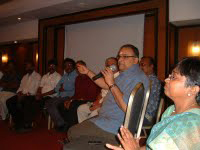
Mohan Raman and others from Kollywood. |
The lyrics by C.R. Anandan, in Tamil, talk about Fort St. George, the city slum dwellers, the Marina Beach, the Covelong Beach, and the Cooum and Adyar Rivers. The song urges Chennaiites to preserve nature’s gifts.
A road accident had claimed Vikram’s life, but his contribution will always be remembered and we hope that his dreams of a better and greener Chennai will be realised some day soon. Vikram had composed the original music for the song.
Later, there was an absorbing presentation on Tamil films through the 1930s to the 1970s by Mohan Raman, a familiar face on television. Mohan has acted in more than 100 films and 5,000 episodes. He remembered many of them in his presentation. It continued past 9.30 pm, but many stayed till the end.
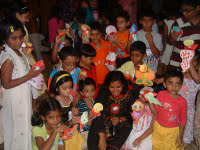
Fauna of the city,seen by young puppet-makers. |
Also talking at the Hotel Green Park about another age in the Kodambakkam studios, and their experiences, were ten people closely associated with the film industry: Balraj, costume designer; Premkumar, cinematographer; Rajendran, make-up artist; Jana, art director; Jananathan, film director; G.B. Vijay, film director and ad filmmaker; J.K., art director; Karthik Raghunath, film director; Ragavendra Rao, actor and lyricist; and Vasantha Anand, actor.
Vijay pointed out that where the Green Park stood was the canteen of Vauhini Studios that served two idlis for five paise. He spoke of the thoughtfulness of the film-makers of those days who provided excellent food at a subsidised rate.
According to Randor Guy, film historian, the Madras Electric Supply Corporation (MESC) had built a power house in the Kodambakkam area, during World War II, but there were no takers for the energy. Film studios were then encouraged to set up shop there. And that’s how film-making came to Kodambakkam and Kollywood was born.
However, he pointed out that as early as 1935, A. Ramaiah from Thanjavur had already established the first studio, Star Combines, near the Vadapalani bus terminus, which then marked the end of city limits. In the years that followed, Rohini Film Centre (set up by Majid), Bharani Studios (Bhanumathy Ramakrishna), Vikram Studios (B.S. Ranga), Paramount which later became Majestic Studios (Muthukumarappa Reddiar), Golden Studios, Vasu Studios (Vasu Menon) and Karpagam Studios (K.S. Gopalakrishnan) were established. But they were all dwarfed by two giants – Vauhini Studios (B. Nagi Reddy), the biggest in Asia then, with 13 shooting floors, and AVM Studios (A.V. Meiyappan), the second largest in the city, with six shooting floors.
It was only in the 1970s that film-makers ventured out from the studios of Kodambakkam. But there has always remained a great demand for studio floor space, according to Karthik Raghunath.

Oxygen who played a Chennai Anthem. |
‘Spring into Reading’ focussed on Kodambakkam and the life in the film studios there for one of its contributions to Madras Week. According to P. Venkataraman, a Kodambakkam resident for 52 years, the place was originally a village in Puliyur Kottam, one of the 24 subdivisions of Thondainadu. There are several versions of how the name Kodambakkam came about – a corrupted form of Ghoda Bagh, the place where horses were stabled during the time of the Nawab of Arcot; the sthalapuranam of one of the two Siva temples in the area (it is said that Lord Siva turned the Meru Mountain into a bow; in Tamil, mountain is kodu, bow is ambu); after Karkodiyan, a descendant of Adisesha who is worshipped as Lord Narayana at the temple in Sivan Koil Street... take your choice.
A few decades ago, there was no Kodambakkam Bridge; there was the ‘periya gate’ near the track that people used to cross. There was always a crowd at the railway gate watching film stars waiting to cross once the trains passed, recalled Karthik Raghu-nath.
Chef Amsa of the Green Park recalled how he and his friends used to walk from Royapettah to watch movies at the Pankajam touring talkies near Arunachalam Road. They paid 25 paise for a tharai (sitting on the sand) ticket or one rupee if they wanted to sit on a chair.
Recapturing the spirit of Ghoda Bagh and the songs and scenes shot in the studios were students from the Dr. M.G.R. Janaki School for the Hearing and Speech Impaired, Ramavaram, and the Dr. M.G.R. Janaki College of Arts and Science for Women, Adyar.
And, perhaps for the first time, Madras Week this year saw ‘Happy birthday, Chennai’, being sung. The children had gathered at the Green Park for a ‘Spring into Reading’ programme conducted by Binita and Shrimati, who organised puppetry workshops and storytelling. Bhanumathi’s puppetry workshop this year was ‘flora and fauna’, more of fauna actually, and the storytelling was by Jeeva Raghunath.
Back to top
|
|
A variety of events
from Avadi to the Marina |
| By Sashi Nair |
|
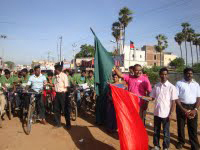
From Avadi to Marina on bikes. |
Elsewhere, VSSS Alumni, a forum of past pupils of the Vijayantha Senior Secondary School on the Heavy Vehicles Factory campus in Avadi, organised a bicycle rally on Madras Day, starting from the Avadi round-tana and riding to the lighthouse on the Marina. The objective: to create awareness about global warming and the measures needed to protect the earth, such as, bicycles for travel up to 5 km, public transport for longer distances, and car/two-wheeler pooling.
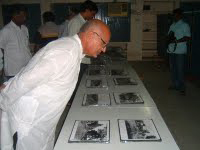
Vintage Madras in Pictures. |
There was a packed hall at the Jaigopal Garodia Vivekananda Vidyalaya Matriculation Higher Secondary School in Anna Nagar for D. Krishnan’s presentation on ‘Pictures of the Madras Presidency’. Krishnan’s pictures contrasted sharply the Madras of yesteryear and the Chennai of today.
One of the big successes of Madras Week this year has been the participation by schools and colleges in a variety of competitions. Nearly 100 schools and colleges took part in the events organised by the Indian National Trust for Art and Cultural Heritage (INTACH), Chennai Chapter. It was a commendable achievement, considering that the city, like many others in India, was in the midst of the H1N1 virus scare. Undeterred, scores of children from Vellaiyan Chettiar School in Tiruvottriyur to Sankara Vidyashram in Tiruvanmiyur, and from Vel’s Vidyashram in Pallavaram to MCtM Senior Secondary School in Purasawalkam, wrote, drew, debated and exhibited. Broadly, the theme centred on coins, in memory of Raja Seetharaman, a well known coin collector and active member of INTACH, who died shortly after Madras Week 2008.
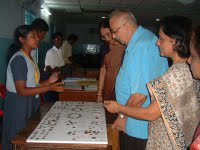
Coin-focussed School exhibitions |
To make a success of these efforts, S. Suresh, convener for INTACH’s Chennai Chapter, and Prema Kasturi, co-convener, visited the various institutions before and during the week, often travelling in discomfort to get to them.
Vanilla Children Place organised a weeklong programme for Madras Week. Yifat, who runs the Place, has always been very enthusiastic in putting on a big programme during the celebrations. This year, she was not in town, but Deepa took up the responsibility and put together quite a list – from talks on wildlife and education in the city to drawing and kolam sessions, to traditional games and storytelling.
The kolam workshop was conducted by Sindhu Suresh. Sindhu grew up in Pollachi, completed her studies in Coimbatore and came to Madras in the 1980s. It was in Pollachi that she picked up the art of drawing kolam-s, from her neighbours. She had a notebook, she says, and in that she would draw any interesting kolam she saw. Sindhu paints as well, on canvas and on glass, mainly decorative and Madhubani paintings.
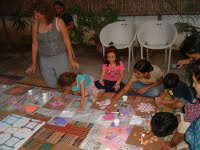
Learning the variety of Kolam. |
V. Narayan Swami’s exhibition of etchings, engravings and aquatints last year, during Madras Week, focussed on Madras city. This year, there were a number of engravings relating to the old Madras Presidency, now the states of Tamil Nadu, Kerala, Karnataka and Andhra Pradesh. As a part of the inauguration of the exhibition at the C.P. Ramaswami Aiyar Foundation was the release of Madras-Chennai, its history and environment, written by Dr. Nanditha Krishna of the Foundation. “We realised that the children were unaware of their history and the environment and there was no simple material that could be used to teach them. That was when I felt that it was imperative to write a simple book which would be readable by the young and the old, and that is how the book came into being,” Nanditha explained. The royalties earned from the sale of the book will go to fund the Foundation’s education charities.
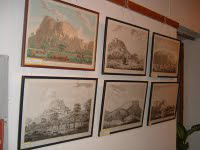
Prints of the Madras Presidency. |
At the Government College of Arts & Crafts, Pradeep Chakravarthy focussed on the Madras of 1862-1876, using photographs taken by students of the College in those days. I had never seen the Madras Central station without a clock tower, but he showed us such a picture. Nor had I seen a picture of the Government Telegraph Office, built in Georgian style, in Errabalu Chetty Street, or of Wooder School in Saidapet, a Western style school (1715), or of the Achhan Koil on Spur Tank Road. They all featured in Pradeep’s presentation. The view of Medical College and Government General Hospital and the Cooum River from the Wallajah or Island Bridge offered views unlike anything today.
There were numerous other fascinating pictures. It is a presentation Pradeep must make more often at other fora.
Back to top
|
|
|
|
|